Virulence of a Mycobacterium tuberculosis clinical isolate in mice is determined by failure to induce Th1 type immunity and is associated with induction of IFN-alpha /beta
- PMID: 11320211
- PMCID: PMC33285
- DOI: 10.1073/pnas.091096998
Virulence of a Mycobacterium tuberculosis clinical isolate in mice is determined by failure to induce Th1 type immunity and is associated with induction of IFN-alpha /beta
Abstract
To understand how virulent mycobacteria subvert host immunity and establish disease, we examined the differential response of mice to infection with various human outbreak Mycobacterium tuberculosis clinical isolates. One clinical isolate, HN878, was found to be hypervirulent, as demonstrated by unusually early death of infected immune-competent mice, compared with infection with other clinical isolates. The differential effect on survival required lymphocyte function because severe combined immunodeficiency (SCID) mice infected with HN878 or other clinical isolates all died at the same rate. The hypervirulence of HN878 was associated with failure to induce M. tuberculosis-specific proliferation and IFN-gamma production by spleen and lymph node cells from infected mice. In addition, 2- to 4-fold lower levels of tumor necrosis factor-alpha (TNF-alpha), IL-6, IL-12, and IFN-gamma mRNAs were observed in lungs of HN878-infected mice. IL-10, IL-4, and IL-5 mRNA levels were not significantly elevated in lungs of HN878 infected mice. In contrast, IFN-alpha mRNA levels were significantly higher in lungs of these mice. To further investigate the role of Type 1 IFNs, mice infected with HN878 were treated intranasally with purified IFN-alpha/beta. The treatment resulted in increased lung bacillary loads and even further reduced survival. These results suggest that the hypervirulence of HN878 may be due to failure of this strain to stimulate Th1 type immunity. In addition, the lack of development of Th1 immunity in response to HN878 appears to be associated with increased induction of Type 1 IFNs.
Figures
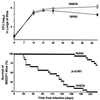
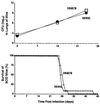
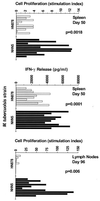
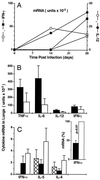
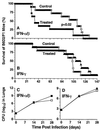
References
-
- Mish FC, editor. Merriam Webster's Collegiate Dictionary. 10th Ed. Springfield, MA: Merriam-Webster; 1998.
-
- Sturgill-Koszycki S, Schlesinger P H, Chakraborty P, Haddix P L, Collins H L, Fok A K, Allen R D, Gluck S L, Heuser J, Russell D G. Science. 1994;263:678–681. - PubMed
-
- Sherman D R, Mdluli K, Hickey M J, Arain T M, Morris S L, Barry C E, 3rd, Stover C K. Science. 1996;272:1641–1643. - PubMed
Publication types
MeSH terms
Substances
Grants and funding
LinkOut - more resources
Full Text Sources
Other Literature Sources

